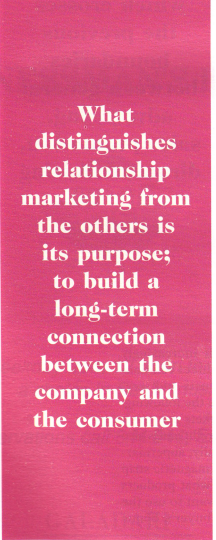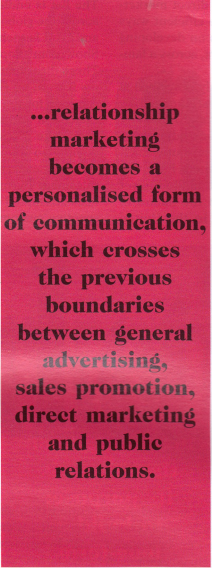This year, a leading automobile distributor in the UAE will make available a fleet of luxury sedans, for the exclusive use of the owners of a major competitor brand for two weeks. Almost 4 million expectant mothers in the USA will receive personalised letters about infant care from a disposable diaper manufacturer. And at supermarkets across the country, shoppers will watch personalised advertisements for chocolates, toothpaste and tea, at check out counters equipped with video screens. In these instances and in countless others, we find that marketers are trying new ways to communicate with their customers in order to capitalise on and cement the long term relationship between the marketer and the consumer.
Marketers are building and maintaining data bases on consumers to customise and target their messages more precisely. On the other side, consumers are signalling their needs and preferences, and will eventually see marketing communications and products tailored to those desires. Greater brand loyalty and sales impact are the goals of this new one-on-one association between the marketer and the consumer.
Relationship marketing is changing the way marketers use traditional media channels to build brand image and awareness. In shifting their marketing from mass media to a more targeted, and more measurable forms of advertising, marketers are not merely reallocating advertising budgets between existing media products, they are also taking advantage of a whole new set of media choices. By utilising these new media choices, they are building relationships — instead of just trying to make a one-time sale which is otherwise termed as a transaction.
As more and more companies turn to relationship marketing, more and more advertising money is being funnelled into proprietary media for communicating directly with consumers. The threats and opportunities facing marketing companies are clear those who fully exploit the technological breakthroughs in such techniques will be able to stay miles ahead of competitors and consolidate their position, whereas those who approach the new avenues with a laid-back attitude and do not develop relationship marketing strategies, will no more be in the playing field; competition will eat them out.
Relationship marketing combines elements of general advertising, sales promotion and direct marketing to create more effective and more efficient ways of reaching the consumers. It centres on developing an ongoing relationship with consumers, across a family of related products and services. The diaper manufacturer previously described is a good example. Huggies, when it was launched by Kimberly Clerk against the generic brand Pampers, of Procter & Gamble, who have enough advertising muscle to ward off any competition, set out a long- term assault of a different kind for which P&G was not yet ready. They earmarked US$10 million to set up a system that provides them with the names of over 75% of the expectant mothers in the United States. The names were obtained from doctors, hospitals and child birth trainers.
During their pregnancies, the mothers-to-be receive personalised magazines and letters with instructions and ideas on baby care, thus building a bond between the mothers and Huggies. When the babies arrive, a coded coupon is delivered, by which Huggies can keep track of which mothers have tried the product. Later, as new technologies fall into place, Huggies will be able to know which mothers continue to purchase Huggies.

In this case, Huggies’ parent, Kimberly Clerk, is not only building diaper sales but also establishing relationships with mothers which can be leveraged across their products. The cost of linking the consumer to the brand can be justified since the per baby consumption of single-use diapers average over US$1500 annually, according to an industry source.
Other innovative programmes include: Kraft’s “Cheese and Macaroni Club”, which sends children a packet of goodies: MTV’s custom magazine which viewers get when they respond to MTV’s 800 number; Isuzu’s personalised inserts in the Time magazine which list the nearest dealerships and are redeemable for a premium. In the United Arab Emirates, there is the UGA scheme for golf novices, Gulf News co-branded credit cards, Frequent Flyer programmes of airlines, Mashreq Bank’s cusomer introduce customer schemes, and many more.
The list is endless if you include other programmes across the globe. Last year saw Galadari Automobiles and Ford launching the first ever interactive “Virtual Showroom” floppy discs and CD ROMS in the region. These discs mailed to potential and existing customers list out all Ford vehicles available. The customer can look for the specifications of each model, change the colour and select one and ask for a price. He can even take a test drive in his favourite car. Before coming to a showroom a customer can enjoy the shopping experience without the pressure from a car salesman. By mailing these discs Galadari Automobiles attempted to build a relationship with their prospective customers. However, because of their poor after sales service quality and part prices, it really did not work out. More than that, as managements changed, an otherwise brilliant idea got shelved. A real shame, indeed. Because relationship marketing combines elements of other communications and disciplines, a natural question arises: How is it different from direct marketing, general advertising or sales promotion? In some ways, it is all these and more. What distinguishes relationship marketing from the others is its purpose; to build a long-term connection between the company and the consumer.
The objective of traditional direct marketing advertisers, such as catalogue merchants or life insurers, is achieved by bypassing the retailer through alternative distribution channels. Traditionally, the use of direct marketing by consumer durables and packaged goods companies has been low and mainly limited to couponing. Advertisers using sales promotion services such as dollars- off coupons, raffles, or “buy one, get one free”, are also geared towards increasing their short term sales by providing an extra pull for their products. Both direct marketing and sales promotion services seek immediate sales.
Relationship marketing does not seek a temporary increase in sales or seek to sell products through the mail, but seeks to create involvement and product loyalty by building a lasting bond with the customer. While it may be used to facilitate product repositioning, gain competitors customers, or help launch new products, the ultimate goal is increased usage over a period of time. With this clear objective, relationship marketing becomes a personalised form of communication, which crosses the previous boundaries between general advertising, sales promotion, direct marketing and public relations.

Dissatisfaction with traditional approaches to building brand loyalty, coupled with advances in technology has driven advertisers to look for new ways of connecting with the consumers. The decrease in the reach of mass media is old news. Newspaper penetration has declined globally, and most house holds now have multiple channel viewing on their TV. The latest news is the flattening growth of direct marketing and sales promotions, apparently as a result of over- kill. The UAE is a case in point. Promotions have proved to be increasingly unsuccessful in stimulating consumers to try new brands. Manufacturers using coupons are only subsidising the purchases of current users, a study shows that 80% of coupons are now used by loyal customers who would have bought the product anyway. And, as postage rates rise, many companies are reconsidering direct response.
Technological innovations make it increasingly possible for each company to have a direct relationship with the people who use its products and services. Among the major innovations are the following:
- Scanning equipment at supermarkets can track individual buying habits. Co-branded credit cards also help supermarkets achieve this. Basically, supermarkets give consumers a card featuring a magnetic strip which permits the computer to know what products the consumer purchases. Consumers want to use the card, because they receive frequent buyer’s bonus points.
- Relational database technology now makes the use and analysis of databases containing large amounts of customer information more manageable.
- New kinds of audience measurement, such as “people meters”, can tell planners which people are watching what. Selective delivery and addressability allow the delivery of differentiated and personalised messages.
- Telecommunication technologies such as automatic number identification and voice response capabilities recognise respondents to advertisements who call the 800 numbers.
These developments come at a time when advertisers need a way to make consumers more receptive to their claims a particularly difficult challenge as consumers are increasingly sceptical about the messages they receive from mass advertising. Messages compete in a more cluttered environment where it is often difficult to distinguish between product advantage and brand identity.
Armed with new database and communication technologies, marketers can deal with their customers as valued individuals and create an environment in which people want to hear the messages they receive. Relationship marketing gives the marketers the potential to build an image and connection, that they can’t do with other media choices.
There are a few strategic opportunities for companies on the leading edge of relationship marketing techniques. We shall discuss these in the next issue of “Business Today”.




